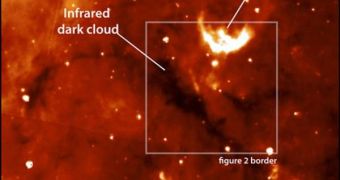Astronomers know that massive, young, blue stars are formed from equally large gas clouds, where high temperatures and chemical concentrations are just right for this to happen. However, until now, they have only observed such formations after they already took shape. In a new sky survey, a team of experts has discovered a hidden, tranquil cloud of matter that they believe will soon give birth to either one or more massive new stars. Their eyes are now pointed in that direction, so as to capture the event.
The impressive cloud is situated inside the Milky Way, more precisely in the Aquila rift, some 23,000 light-years away – which, by astronomy's standards, is very near. The formation is about 120 times heavier than our own Sun, which is a yellow dwarf, but it's compacted in a region of the sky smaller than that of the Oort Comet Cloud, which orbits our solar system. Experts made the announcement yesterday, June 9th, at the 214th meeting of the American Astronomical Society, in Pasadena, Calif.
The formation process of massive stars (eight or more times heavier than the Sun) is very little understood, mostly because these stars live a short life, during which they emit large amounts of radiation. When they reach the end of their burning cycle, they explode into supernovas, with such intensities that they can outshine even large galaxies for short periods of time. These massive explosions wipe out any traces of their surroundings, so experts can only hypothesize that it's dust clouds that form them.
Now, as they are constantly monitoring the cloud, which is very cold at -427 degrees Fahrenheit (-255 degrees Celsius), they hope to get the first glimpses of the processes that lead to the formation of a very hot, large star from a nearly absolute-zero structure. It has been found via the Submillimeter Array (SMA), on mount Mauna Kea in Hawaii.
“Perhaps the most exciting thing is that we now know that massive and dense cores with no sign of star formation activity do exist. The mass and density of this object along with the lack of evidence for star formation activity is unique, and this fits very well with our expectations for massive pre-stellar cores,” LiveScience quotes University of Hawaii at Manoa expert Jonathan Swift as saying. He is one of the members of the team that made the recent find.

 14 DAY TRIAL //
14 DAY TRIAL //